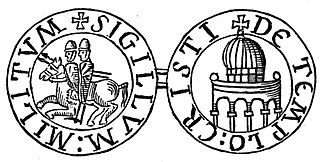
The Poor Fellow-Soldiers of Christ and of the Temple of Solomon, mainly known as the Knights Templar, was a military order of the Catholic faith, and one of the wealthiest and most popular military orders in Western Christianity. They were founded c. 1119, headquartered on the Temple Mount in Jerusalem, and existed for nearly two centuries during the Middle Ages.

The Seventh Crusade (1248–1254) was the first of the two Crusades led by Louis IX of France. Also known as the Crusade of Louis IX to the Holy Land, it aimed to reclaim the Holy Land by attacking Egypt, the main seat of Muslim power in the Near East. The Crusade was conducted in response to setbacks in the Kingdom of Jerusalem, beginning with the loss of the Holy City in 1244, and was preached by Innocent IV in conjunction with a crusade against emperor Frederick II, Baltic rebellions and Mongol incursions. After initial success, the crusade ended in defeat, with most of the army – including the king – captured by the Muslims.
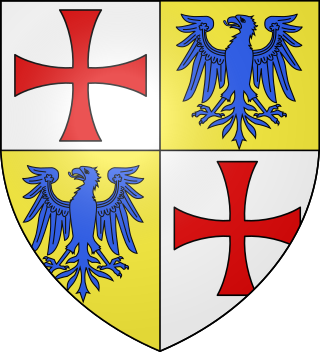
Robert IV de Sablé was Lord of Sablé, the eleventh Grand Master of the Knights Templar from 1191 to 1192 and Lord of Cyprus from 1191 to 1192. He was known as the Grand Master of the Knights Templars and the Grand Master of the Holy and Valiant Order of Knights Templars.

Guillaume de Sonnac was Grand Master of the Knights Templar from 1247 to 1250.

Armand de Lavoie (or Hermann de Lavoie was a descendant of the Counts of Périgord and a Grand Master of the Knights Templar.

The siege of Acre took place in 1291 and resulted in the Crusaders' losing control of Acre to the Mamluks. It is considered one of the most important battles of the period. Although the crusading movement continued for several more centuries, the capture of the city marked the end of further crusades to the Levant. When Acre fell, the Crusaders lost their last major stronghold of the Crusader Kingdom of Jerusalem. They still maintained a fortress at the northern city of Tartus, engaged in some coastal raids, and attempted an incursion from the tiny island of Ruad; but, when they lost that, too, in 1302, in the siege of Ruad, the Crusaders no longer controlled any part of the Holy Land.
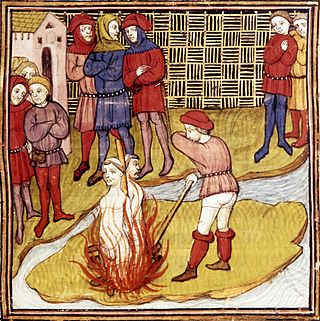
The Poor Fellow-Soldiers of Christ and the Temple of Jerusalem, or Templars, was a military order founded in 1119/20.

The Crusades were a series of religious wars initiated, supported, and sometimes directed by the Christian Latin Church in the medieval period. The best known of these military expeditions are those to the Holy Land in the period between 1095 and 1291 that were intended to reconquer Jerusalem and its surrounding area from Muslim rule. Beginning with the First Crusade, which resulted in the conquest of Jerusalem in 1099, dozens of military campaigns were organised, providing a focal point of European history for centuries. Crusading declined rapidly after the 15th century.

Guillaume de Villaret, was the twenty-fourth Grand Master of the Knights Hospitaller, a position he held from 1296 until 1305, succeeding Odon de Pins. He was succeeded by his nephew, Foulques de Villaret, whose career he had done much to advance.

Renaud (Reginald) de Vichiers was the 19th Grand Master of the Knights Templar from 1250 to 1256.

Guillaume de Beaujeu, aka William of Beaujeu was the 21st Grand Master of the Knights Templar, from 1273 until his death during the siege of Acre in 1291. He was the last Grand Master to preside in Palestine.

The Knight Templar is the second book in Jan Guillou's The Knight Templar book series. This book follows the fictional character of Arn Magnusson as a Knight Templar in the kingdom of Jerusalem. The book starts in Arn's 27th year and ends as he departs the holy lands.

Jean de Villiers was the twenty-second Grand Master of the Knights Hospitaller, serving from 1285 until 1293. He was elected Grand Master after the death of Nicolas Lorgne. De Villiers was Prior of France beginning in 1282 and he remained in France to deal with existing problems of the Order. Jacques de Taxi became Grand Master ad interim, perhaps through 27 June 1286, while awaiting the arrival of the newly elected Grand Master in the Holy Land. De Villiers was present at the Siege of Acre in 1291, but escaped just before the city fell to the Mamluks. He was succeeded by Odon de Pins.
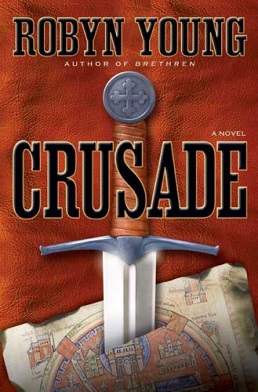
Crusade is a novel by Robyn Young set during the end of the ninth and final crusade. It was first published by Dutton in 2007.

The fall of Ruad in 1302 was one of the culminating events of the Crusades in the Eastern Mediterranean. In 1291, the Crusaders had lost their main power base at the coastal city of Acre, and the Muslim Mamluks had been systematically destroying the remaining Crusader ports and fortresses in the region, forcing the Crusaders to relocate the dwindling Kingdom of Jerusalem to the island of Cyprus. In 1299–1300, the Cypriots sought to retake the Syrian port city of Tortosa, by setting up a staging area on Ruad, two miles (3 km) off the coast of Tortosa. The plans were to coordinate an offensive between the forces of the Crusaders, and those of the Ilkhanate. However, though the Crusaders successfully established a bridgehead on the island, the Mongols did not arrive, and the Crusaders were forced to withdraw the bulk of their forces to Cyprus. The Knights Templar set up a permanent garrison on the island in 1300, but the Mamluks besieged and captured Ruad in 1302. With the loss of the island, the Crusaders lost their last foothold in the Holy Land and it marked the end of crusader presence in the Levant region.

Pierre de Vieille-Brioude, or Vieille-Bride, was a nobleman from Auvergne who was the eighteenth Grand Master of the Knights Hospitaller between 1240 and 1242, succeeding Bertrand de Comps. He was succeeded by Guillaume de Chateauneuf.
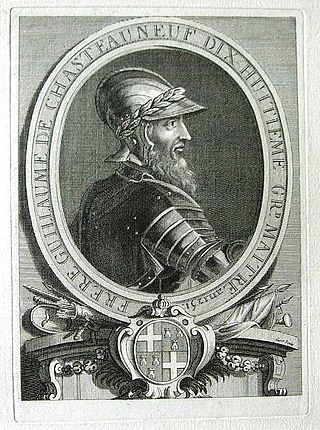
Guillaume de Chateauneuf was the nineteenth Grand Master of the Knights Hospitaller, serving first from 1242–1244 as the successor to Pierre de Vieille-Brioude. He was captured during the Battle of La Forbie in 1244, held hostage in Egypt and ransomed through the Sixth Crusade. During his captivity, his position was filled on an interim basis by Jean de Ronay. De Ronay died in 1250, and de Chateauneuf was released shortly thereafter. He was succeeded by Hugues de Revel.
Jean de Ronay was knight of the Order of Saint John of Jerusalem who was appointed Grand Commander of the Knights Hospitaller by the Grand Master Guillaume de Chateauneuf in 1243 or 1244. He served as interim Grand Master of the Knights Hospitaller from 1244 to 1250 during the captivity of de Chateauneuf. He died in battle during the Seventh Crusade.

The fall of Outremer describes the history of the Kingdom of Jerusalem from the end of the last European Crusade to the Holy Land in 1272 until the final loss in 1302. The kingdom was the center of Outremer—the four Crusader states—formed after the First Crusade in 1099 and reached its peak in 1187. The loss of Jerusalem in that year began the century-long decline. The years 1272–1302 are fraught with many conflicts throughout the Levant as well as the Mediterranean and Western European regions, and many Crusades were proposed to free the Holy Land from Mamluk control. The major players fighting the Muslims included the kings of England and France, the kingdoms of Cyprus and Sicily, the three Military Orders and Mongol Ilkhanate. Traditionally, the end of Western European presence in the Holy Land is identified as their defeat at the Siege of Acre in 1291, but the Christian forces managed to hold on to the small island fortress of Ruad until 1302.

The history of the Knights Hospitaller in the Levant is concerned with the early years of the Order of the Hospital of St. John of Jerusalem, the Knights Hospitaller, through 1309. The Order was formed in the later part of the eleventh century and played a major role in the Kingdom of Jerusalem, in particular, the Crusades. This lasted until the West was expelled from the Holy Land, with the Order conquering Rhodes in the early fourteenth century. Among the most important internal events of the early years of the kingdom were the foundation of the Military Orders, which included the Hospitallers, the Knights Templar and the Teutonic Order. Unlike the Hospitallers' beginnings as a benevolent organization, the Templars and Teutonic knights began with a military mission. These three major Orders would play a major role in the military activities of the kingdom, sometimes cooperatively, sometimes not. On the battlefield they frequently shared among them the most important tactical roles, the vanguard and rear-guard.










































